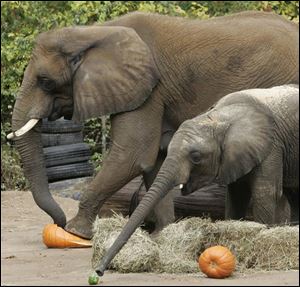
Zoo's master plan envisions new taxes to promote growth
11/13/2005
Elephants Renee and Louie would live in a larger facility under the Toledo Zoo's proposed 10-year master plan that calls for expanding the home for the pachyderms.
In the next decade, the Toledo Zoo would like to build the best aquarium between Chicago's Shedd and the Newport Aquarium in Kentucky.
It wants to make room for more elephants.
In hopes of making baby rhinos, it would provide more generous quarters for frisky rhinoceroses.
And children would find a special place at a proposed Children's Zone to replace the children's zoo.
Those are just some of the ideas laid out in a $109 million, 10-year master plan that the zoo's board of directors will consider at their meeting tomorrow.
The master plan includes elements designed to increase zoo attendance, such as a combined aquarium/education center.
It addresses more mundane needs as well - parking, a better phone system, and an alternative energy generation system to help stabilize power costs.
It also covers such nuts-and-bolts requirements as paying off debt from previous construction projects and the regular maintenance of a $100 million institution with 70-year-old buildings.
The fate of the ambitious plan depends on voters.
In previous years, tax issues supporting the zoo were a sure bet.
The capital improvement levy that expires this year paid for the previous 10-year plan that included the Africa exhibit and a new home for the polar bears, in addition to making Toledo home to its own wolf pack.
Any hope of replacing that levy before it expired vanished in the swirl of controversy that began in February with the firing of the zoo's longtime chief veterinarian.
A months-long public battle over zoo operations resulted in an investigation by a county commissioner-appointed task force and the retirement of the zoo's longtime executive director.
For perhaps the first time in zoo history, public support lagged as donations and zoo memberships plummeted.
"Clearly, we had some matters that needed to be attended to,'' said Stephen Staelin, the zoo board's president.
And before the zoo asked voters for money, it needed to address issues raised by the task force, he said.
In October, the county commissioners gave the zoo board high marks for its response to the task force's recommendations, and board members were emboldened to consider approaching voters.
Although plans are not final, voters could see two zoo tax issues on the ballot this spring - a 1-mill, 10-year capital improvement levy and an 0.85-mill, five-year operating levy.
The two issues together would cost the owner of a $100,000 home approximately $56 a year, about $20 more than zoo levies today.
In five years, the zoo may turn to the voters again and ask for another capital levy that could be as small as 0.15 mills, Mr. Staelin said.
At the same time, the zoo's operating levy would expire, and a new operating levy would cover operational costs for the new aquarium.
Behind all this planning is a new resolve on the part of the zoo board: no new debt. Instead, the zoo is adopting a pay-as-you-go philosophy.
That means future master plans will be relieved of the burden of paying for earlier projects.
This master plan includes $17.8 million to service debt.
The priciest part of the master plan is the $43.8 million aquarium/education center.
To build the facility, the exterior of the 1939 aquarium building used today would be preserved.
But inside, it would be a new world.
Visitors would see a two-level facility, with 1,000 more fish. The largest tank would extend two stories.
Tank capacity would increase from a modest 46,000 gallons to 410,000 gallons, said George Oravecz, chairman of the master plan committee.
The new aquarium/education center would be "a destination point for the community," Mr. Oravecz said.
"This is something that is not available in any community near us,'' said Rick Payeff, the zoo's construction manager.
He said the closest facilities of the quality of the one being proposed are the Shedd Aquarium in Chicago and the Newport Aquarium across the Ohio River from Cincinnati.
The education part of the facility would allow the zoo to expand its school programs for children, and even offer adult classes in conjunction with the University of Toledo.
The zoo would collaborate with UT's engineering college to develop a co-generation facility; it would provide heat while making electricity to supply power to the zoo's biggest power consumers - the aquarium and the arctic exhibit.
Plans are tentative, but Mr. Oravecz said he hopes to see the zoo venture into hydrogen fuel. Equipment for that venture would cost an estimated $3.3 million.
Other projects in the plan:
While the zoo offers supplemental parking and a shuttle to it, many people don't bother.
The satellite parking operation costs $65,000 a year and an untold amount in lost gate receipts.
The zoo plans to add more than 800 parking spaces at the Anthony Wayne Trail entrance and 120 spaces on the Broadway side. Together, those projects would cost $4.9 million.
Among the ideas under consideration, a chance to interact with sea creatures. Price tag: $5.5 million.
Renee the elephant needs girlfriends. The American Zoo and Aquarium Association recommends that highly social female elephants be kept in groups of three or more, and right now it's just Renee and her youngster, 2-year-old Louie.
But it's not all about the girls. The zoo would toughen its elephant-handling facility for the rugged needs of a male elephant.
The zoo's two rhinos, at 32 and 37 years of age, aren't about to expand the zoo's rhino population. But with a bigger home for the African animals, Toledo would acquire younger animals and create a breeding program.
Cost of that expansion: $14.4 million.
Contact Jenni Laidman at: jenni@theblade.com or 419-724-6507.